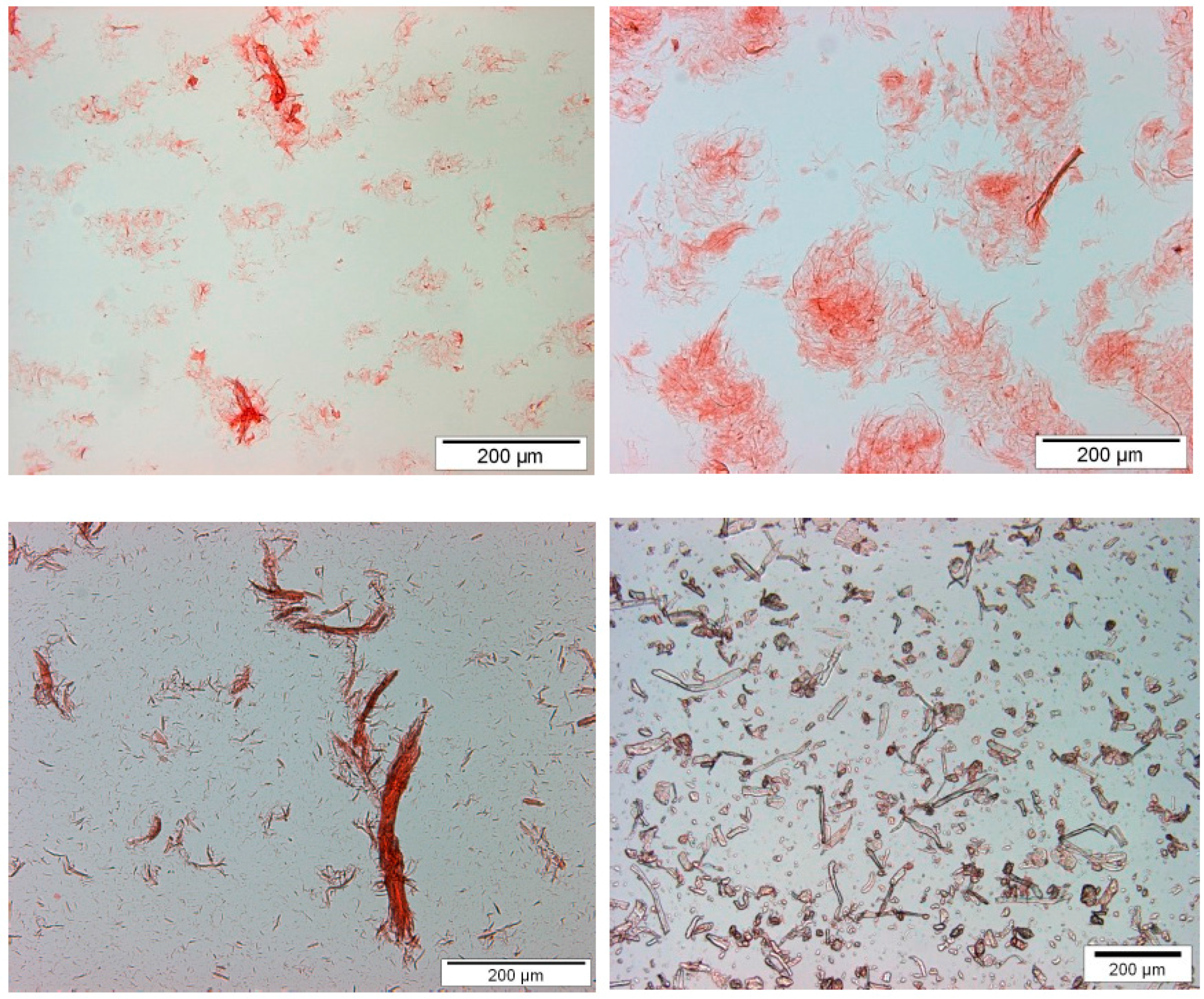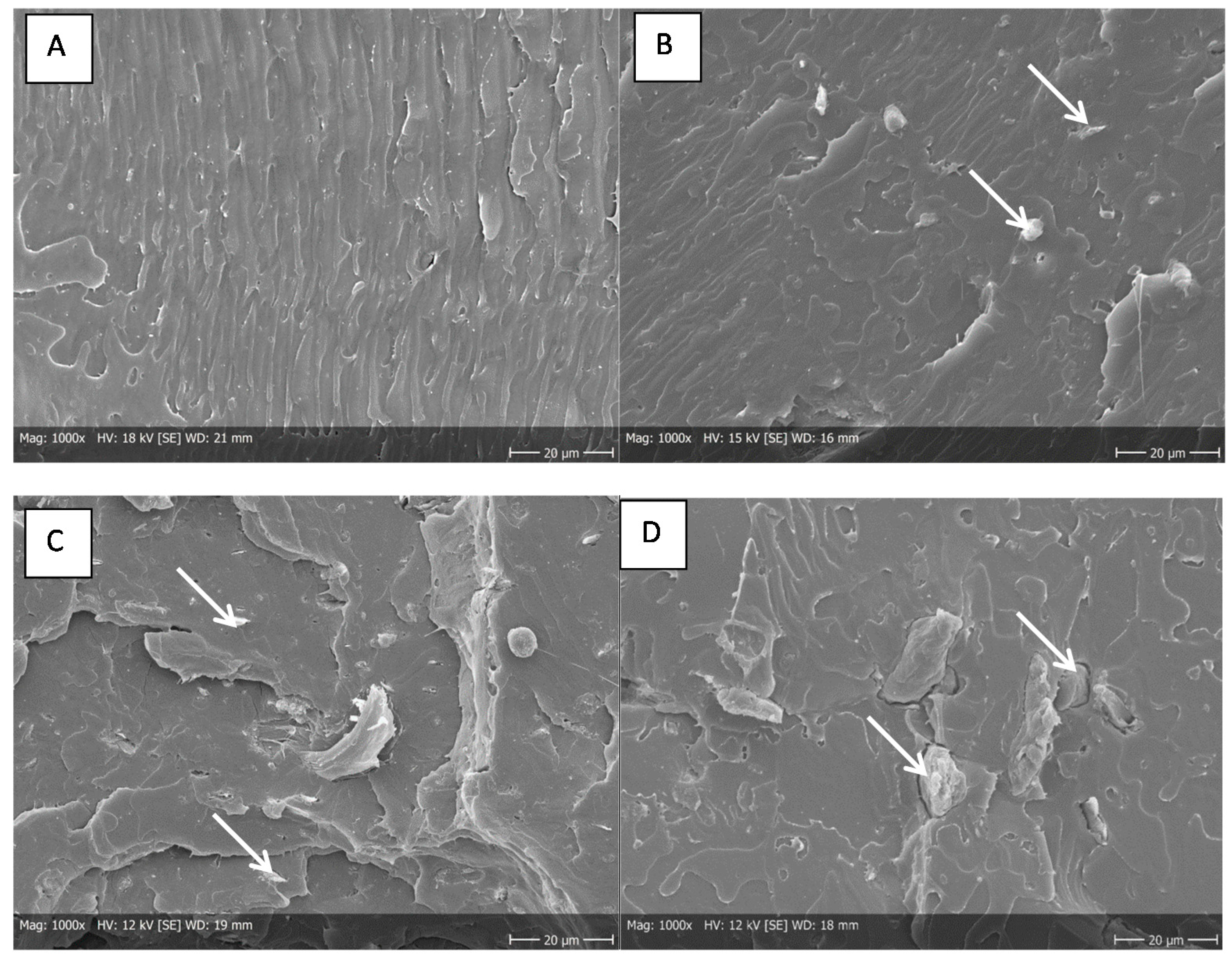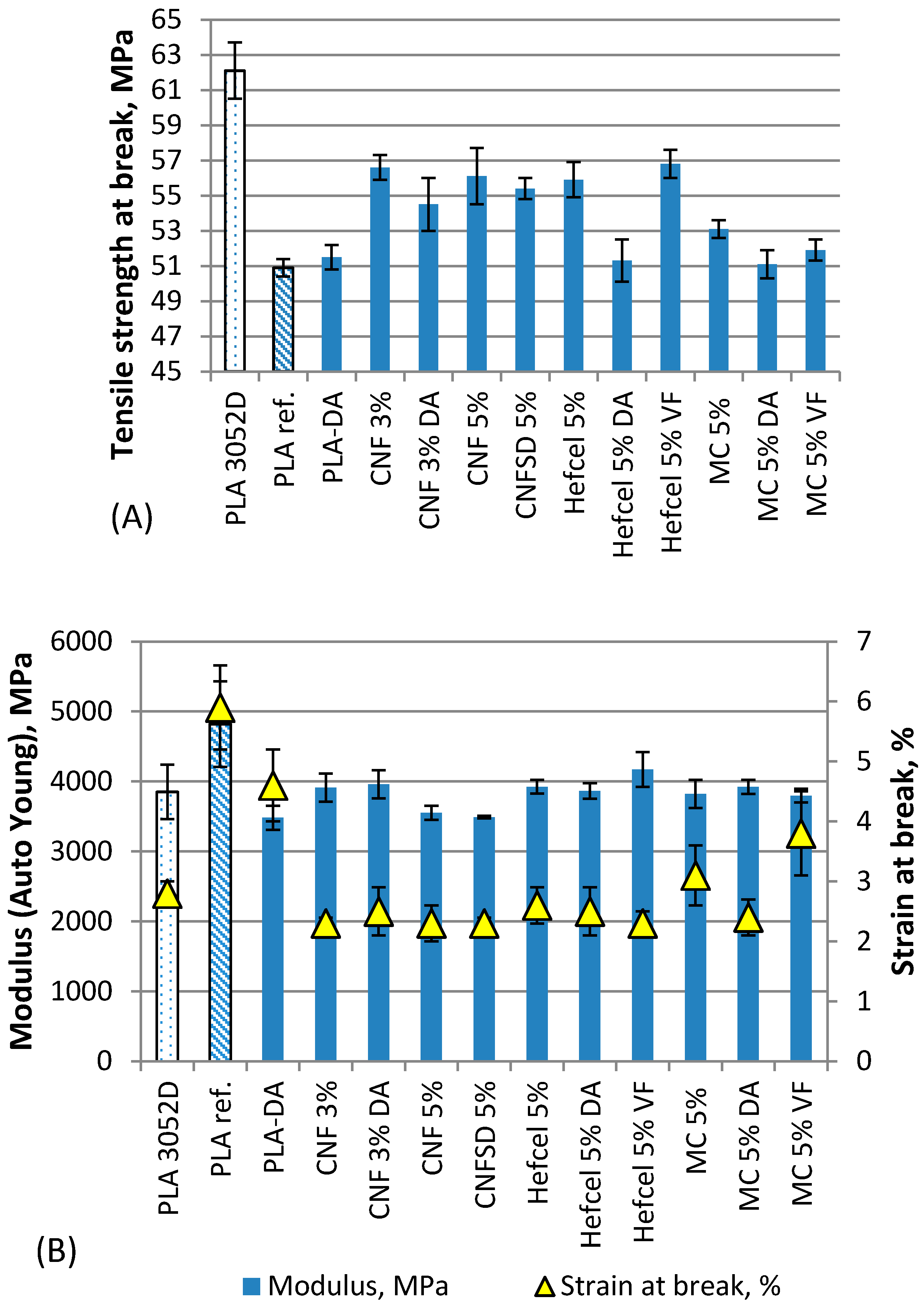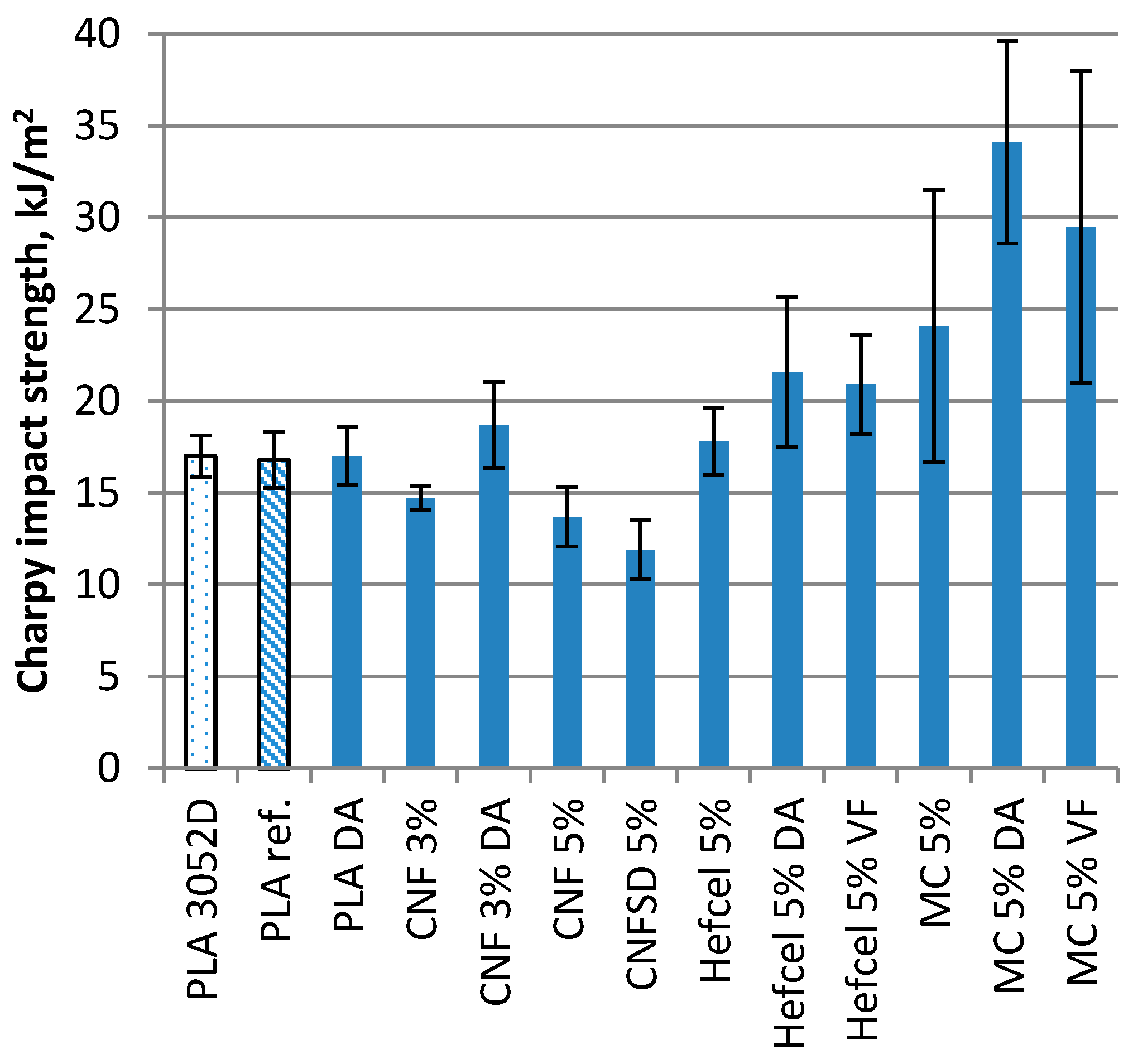Effects of Surfactants on the Preparation of Nanocellulose-PLA Composites
Abstract
:1. Introduction
2. Materials and Methods
2.1. Polymer
2.2. Nanocellulose Preparation
2.3. High-Consistency Nanocellulose Preparation
2.4. Microcellulose
2.5. Nanocellulose Modification and Surface Treatments
2.6. Drying
2.7. Plastic Processing
2.8. Mechanical Testing
2.9. SEM and Optical Microscopy
3. Results and Discussion
3.1. Characterisation of Micro- and Nanocellulose Fibers
3.2. Characterisation of Injection Moulded Test Bars
3.2.1. SEM
3.2.2. Mechanical Results
4. Conclusions
Acknowledgments
Author Contributions
Conflicts of interest
References
- Mohanty, A.K.; Misra, M.; Drzal, L.T. Sustainable Bio-Composites from Renewable Resources: Opportunities and Challenges in the Green Materials World. J. Polym. Environ. 2002, 10, 19–26. [Google Scholar] [CrossRef]
- Lovett, J.; de Bie, F. Corbion Whitepaper Sustainable Sourcing of Feedstocks for Bioplastics. 2016. Available online: www.corbion.com/bioplastics (accessed on 8 November 2017).
- Masutani, K.; Kimura, Y. PLA Synthesis. From the Monomer to the Polymer. In Poly(Lactic Acid) Science and Technology: Processing, Properties, Additives and Applications; RSC Polymer Chemistry Series No. 12; The Royal Society of Chemistry: Cambridge, UK, 2015; Chapter 1. [Google Scholar]
- Sahari, J.; Sapuan, S.M. Natural fibre reinfroced biodegradable polymer composites. Rev. Adv. Mater. Sci. 2011, 30, 166–174. [Google Scholar]
- Oksman, K.; Skrivfars, M.; Selin, J.-F. Natural fibres as reinforcements in polylactic acid (PLA) composites. Compos. Sci. Technol. 2003, 63, 1317–1324. [Google Scholar] [CrossRef]
- Tawakkal, I.S.M.A.; Talib, R.A.; Abdan, K.; Ling, C.N. Mechanical and physical properties of Kenaf-derived cellulose (KDC)-filled polylactic acid (PLA) composites. BioResources 2012, 7, 1643–1655. [Google Scholar] [CrossRef]
- Huda, M.S.; Drzal, L.T.; Misra, M.; Mohanty, A.K. Wood-Fiber-Reinforced Poly(lactic acid) Composites: Evaluation of the Physicomechanical and Morphological Properties. J. Appl. Polym. Sci. 2006, 102, 4856–4869. [Google Scholar] [CrossRef]
- Mathew, A.P.; Oksman, K.; Sain, M. Mechanical Properties of Biodegradable Composites from Poly Lactic Acid (PLA) and Microcrystalline Cellulose (MCC). J. Appl. Polym. Sci. 2005, 97, 2014–2025. [Google Scholar] [CrossRef]
- Vehovec, T.; Gartner, A.; Planinšek, O.; Obreza, A. Influence of different types of commercially available microcrystalline cellulose on degradation of perindopril erbumine and enalapril maleate in binary mixtures. Acta Pharm. 2012, 62, 515–528. [Google Scholar] [CrossRef] [PubMed]
- Kalia, S.; Dufresne, A.; Cherian, B.M.; Kaith, B.S.; Avérous, L.; Njuguna, J.; Nassiopoulus, E. Cellulose-Based Bio- and nanocomposites: A Review. Int. J. Polym. Sci. 2011, 2011, 837875. [Google Scholar] [CrossRef]
- Lee, K.-Y.; Aitomäki, Y.; Berglund, L.A.; Oksman, K.; Bismarck, A. On the use of nanocellulose as reinforcement in polymer matrix composites. Compos. Sci. Technol. 2014, 105, 15–27. [Google Scholar] [CrossRef]
- Henze, H.-P. From Nanocellulose Science toward Applications PulPaper 2010; Conference presentation VTT Technical Research Center of Finland: Helsinki, Finland, 2010. [Google Scholar]
- Ketabchi, M.R.; Khalid, M.; Ratnam, C.T.; Walwekar, R. Mechanical and thermal properties of polylactic acid composites reinforced with cellulose nanoparticles extracted from kenaf fibre. Mater. Res. Express 2016, 3, 125301. [Google Scholar] [CrossRef]
- Jonoobi, M.; Harun, J.; Mathew, A.P.; Oksman, K. Mechanical properties of cellulose nanofiber (CNF) reinforced polylactic acid (PLA) prepared by twin screw extrusion. Compos. Sci. Technol. 2010, 70, 1742–1747. [Google Scholar] [CrossRef]
- Islam, M.T.; Alam, M.M.; Zoccola, M. Review on modification of nanocellulose for application in composites. Int. J. Innov. Res. Sci. Eng. Technol. 2013, 2, 5444–5451. [Google Scholar]
- Song, Z.; Xiao, H.; Zhao, Y. Hydrophobic-modified nano-cellulose fiber/PLA biodegradable composites for lowering water vapor transmission rate (WVTR) of paper. Carbohydr. Polym. 2014, 111, 442–448. [Google Scholar] [CrossRef] [PubMed]
- Robles, E.; Urruzola, I.; Labidi, J.; Serrano, L. Surface-modified nano-cellulose as reinforcement in poly(lactic acid) to conform new composites. Ind. Crops Prod. 2015, 71, 44–53. [Google Scholar] [CrossRef]
- Lönnberg, H.; Zhou, Q.; Brumer, H.; Teeri, T.T.; Malmström, E.; Hult, A. Grafting of Cellulose Fibers with Poly(ε-caprolactone) and Poly(l-lactic acid) via Ring-Opening Polymerization. Biomacromolecules 2006, 7, 2178–2185. [Google Scholar] [CrossRef] [PubMed]
- Ng, H.-M.; Sin, L.T.; Bee, S.-T.; Tee, T.T.; Rahmat, A.R. A Review of Nanocellulose Polymer Composites Characteristics and Challenges. Polym. Plast. Technol. Eng. 2016, 56, 687–731. [Google Scholar] [CrossRef]
- Lu, Y.; Calderón, C.M.; Lara-Curzio, E.; Ozcan, S. Improved mechanical properties of polylactide nanocomposites-reinforced with cellulose nanofibrils through interfacial engineering via amine-functionalization. Carbohydr. Polym. 2015, 131, 208–217. [Google Scholar] [CrossRef] [PubMed]
- Bulota, M.; Kreitsmann, K.; Hughes, M.; Paltakari, J. Acetylated mcrofibrillated cellulose as a toughening agent in poly(lactic acid). J. Appl. Polym. Sci. 2012, 126, E448–E457. [Google Scholar] [CrossRef]
- Oksman, K.; Aitomäki, Y.; Mathew, A.P.; Siqueira, G.; Zhou, Q.; Butylina, S.; Tanpichai, S.; Zhou, X.; Hooshmand, S. Review of the recent developments in cellulose nanocomposite processing. Compos. Part A 2016, 83, 2–18. [Google Scholar] [CrossRef]
- Evonik AROSURF PA 780: Highly Absorbent, VOC-Free, Cuts Impact on Fluff Pulp Absorbency, Capacity. Available online: http://www.paperindustrymag.com/issues/Feb11/evonik.html (accessed on 26 November 2017).
- Buong, W.C.; Nor, A.I.; Yoon, Y.T.; Yuet, Y.L. Epoxidized Vegetable Oils Plasticized Poly(lactic acid) Biocomposites: Mechanical, Thermal and Morphology Properties. Molecules 2014, 19, 16024–16038. [Google Scholar] [CrossRef]
- Miao, S.; Liu, K.; Wang, P.; Su, Z.; Zhang, S. Preparation and Characterization of Epoxidized Soybean Oil-Based Paper Composite as Potential Water-Resistant Materials. J. Appl. Polym. Sci. 2015, 132, 41575. [Google Scholar] [CrossRef]
- May, C.A. (Ed.) Epoxy Resins, Chemistry and Technology, 2nd ed.; Cellulose Fibres; CRC Press: New York, NY, USA, 1988; Chapter 11; p. 960. [Google Scholar]
- Ansari, F.; Galland, S.; Johansson, M.; Plummer, C.J.G.; Berglund, L.A. Cellulose nanofiber network for moisture stable, strong and ductile biocomposites and increased epoxy curing rate. Compos. Part A 2014, 63, 35–44. [Google Scholar] [CrossRef]
- Ingeo PLA 3052D Technical Data Sheet. Available online: http://www.natureworksllc.com/~/media/Files/NatureWorks/Technical-Documents/Technical-Data-Sheets/TechnicalDataSheet_3052D_injection-molding_pdf.pdf (accessed on 26 October 2017).
- Virtanen, S.; Wikström, L.; Immonen, K.; Anttila, U.; Retulainen, E. Cellulose kraft pulp reinforced polylactic acid (PLA) composites: Effect of fibre moisture content. AIMS Mater. Sci. 2016, 3, 756–769. [Google Scholar] [CrossRef]
- Chemical Trading Guide. Available online: http://www.guidechem.com/reference/dic-15945.html (accessed on 20 September 2017).
- Arosurf Softness Solutions for Tissue and Fluff Pulp, Product Overwiev, Evonik. Available online: http://www.tissueadditives.com/product/tissue-additives/Documents/Softness-solutions-for-tissue-and-fluff-pulp-EN.pdf (accessed on 15 February 2017).
- Arosurf PA 780 MSDS from Evonik; Manufacturer Evonik: Essen, Germany.
- Vikoflex 7190 Product Description, Arkema. Available online: http://www.arkemaepoxides.com/export/sites/epoxides/.content/medias/downloads/literature/vikoflex-7190.pdf (accessed on 26 October2017).
- Lee, C.S.; Ooi, T.L.; Chuah, C.H. The Effect of Reaction Temperature on Retaining Oxirane Oxygen Contents in the Synthesis of Epoxidized Diethanolamides. Am. J. Appl. Sci. 2009, 6, 72–77. [Google Scholar] [CrossRef]
- Kangas, H.; Lahtinen, P.; Sneck, A.; Saariaho, A.-M.; Laitinen, O.; Hellen, E. Characterization of fibrillated celluloses. A short review and evaluation of characteristics with a combination of methods. Nordic Pulp Pap. Res. J. 2014, 29, 129–143. [Google Scholar] [CrossRef]
- J. Rettenmeier & Söhne. Fibres for Construction Chemical Products 02/2014; Product brochure. JRS Pharma, 2014. Available online: http://www.jrspharma.com (accessed on 2 February 2014).
- Tábi, T.; Sajó, I.E.; Szabó, F.; Luyt, A.S.; Kovács, J.G. Crystalline structure of annealed polylactic acid and its relation to processing. eXPRESS Polym. Lett. 2010, 4, 659–688. [Google Scholar] [CrossRef]
- Martin, C. Compounding PLA on Twin-screw: What Testing Reveals. Plastics Technology, 21 March 2014. Available online: http://www.ptonline.com/articles/compounding-pla-on-twin-screws-what-testing-reveals(accessed on 11 September 2017).
- Courgneau, C.; Rusu, D.; Henneuse, C.; Ducruet, V.; Lacrampe, M.-F.; Krawczak, P. Characterisation of low-odour emissive polylactide/cellulose fibre biocomposites for car interior. eXPRESS Polym. Lett. 2013, 7, 787–804. [Google Scholar] [CrossRef]
- Wang, Y.; Steinhoff, B.; Brinkmann, C.; Alig, I. IN-line monitoring of the thermal degradation of poly(l-lactic acid) during melt extrusion by UV-vis spectroscopy. Polymer 2008, 49, 1257–1265. [Google Scholar] [CrossRef]
- Arjmandi, R.; Hassan, A.; Haafiz, M.K.M.; Zakaria, Z. Effects of Micro- and Nano-cellulose on Tensile and Morphological Properties of Montmorillonite Nanoclay Reinforced Polylactic Acid Nanocomposites. In Nanoclay Reinforced Polymer Composites; Jawaid, M., Qaiss, A., Bouhfid, R., Eds.; Engineering Materials; Springer: Singapore, 2016; pp. 103–125. ISBN 978-981-10-0950-1. [Google Scholar] [CrossRef]
- Sehaqui, H.; Zhou, Q.; Ikkala, O.; Berglund, L.A. Strong and Tough Cellulose Nanopaper with High Specific Surface Area and Porosity. Biomacromolecules 2011, 12, 3638–3644. [Google Scholar] [CrossRef] [PubMed]
- Spence, K.L.; Venditti, R.A.; Rojas, O.J.; Habibi, Y.; Pawlak, J.J. The effect of chemical composition on microfibrillar cellulose films from wood pulps: Water interactions and physical properties for packaging applications. Cellulose 2010, 17, 835–848. [Google Scholar] [CrossRef]







| Fiber | Fiber Length, µm | Mean Fiber Width, nm |
|---|---|---|
| CNF/CNFSD | <10 | 15–40 |
| HefCel | 0.2–0.5 | 15–20 |
| MC | Average 60 [36] | n.a. |
© 2017 by the authors. Licensee MDPI, Basel, Switzerland. This article is an open access article distributed under the terms and conditions of the Creative Commons Attribution (CC BY) license (http://creativecommons.org/licenses/by/4.0/).
Share and Cite
Immonen, K.; Lahtinen, P.; Pere, J. Effects of Surfactants on the Preparation of Nanocellulose-PLA Composites. Bioengineering 2017, 4, 91. https://doi.org/10.3390/bioengineering4040091
Immonen K, Lahtinen P, Pere J. Effects of Surfactants on the Preparation of Nanocellulose-PLA Composites. Bioengineering. 2017; 4(4):91. https://doi.org/10.3390/bioengineering4040091
Chicago/Turabian StyleImmonen, Kirsi, Panu Lahtinen, and Jaakko Pere. 2017. "Effects of Surfactants on the Preparation of Nanocellulose-PLA Composites" Bioengineering 4, no. 4: 91. https://doi.org/10.3390/bioengineering4040091







